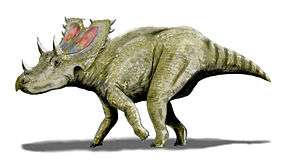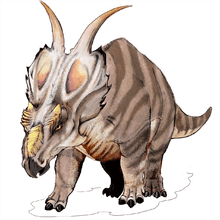Agujaceratops
| Agujaceratops mariscalensis Temporal range: Late Campanian, 77 Ma | |
|---|---|
 | |
| Skeletal restoration | |
| Scientific classification | |
| Kingdom: | Animalia |
| Phylum: | Chordata |
| Class: | Reptilia |
| Clade: | Dinosauria |
| Order: | †Ornithischia |
| Family: | †Ceratopsidae |
| Subfamily: | †Chasmosaurinae |
| Genus: | †Agujaceratops Lucas, Sullivan & Hunt 2006 |
| Species: | †A. mariscalensis |
| Binomial name | |
| Agujaceratops mariscalensis (Lehman, 1989 [originally Chasmosaurus]) | |
Agujaceratops (meaning "Horned face from Aguja") is a genus of herbivorous ceratopsian dinosaur. It is a chasmosaurine ceratopsian which lived during the Late Cretaceous period (late Campanian stage) in what is now Texas. Originally known as Chasmosaurus mariscalensis and described by Lehman in 1989, it was moved to a new genus by Lucas, Sullivan and Hunt in 2006. Lehman felt the habitat Agujaceratops lived in (at least where the fossil material was found) may have been a swamp, due to the nature of the sediments. Lehman, Wick & Barnes (2016) described a second species, Agujaceratops mavericus.[1]
Discovery and species

In 1938, three dinosaur bone beds were excavated, and ceratopsian material was collected from Big Bend National Park (Texas) by William Strain. This material was studied by Lehman in 1989[2] and named Chasmosaurus mariscalensis. It is known only from the holotype UTEP P.37.7.086 a partial adult skull which includes a braincase, left supraorbital horncore, left maxilla and a right dentary. Additional material was associated with the holotype, but not considered to be part of it. All specimens of Agujaceratops were collected from the lower part of the Upper Shale member of the Aguja Formation, dating to about 77 million years ago,[3] in the Big Bend National Park, Brewster County. Subsequent analysis resulted in the taxon being put in its own genus. Agujaceratops was named by Spencer G. Lucas, Robert M. Sullivan and Adrian Hunt in 2006, and the type species is Agujaceratops mariscalensis. Agujaceratops is similar to both Pentaceratops and Chasmosaurus. Its short frill suggests it probably was not an ancestor of Pentaceratops.
See also
References
- ↑ Thomas M. Lehman; Steven L. Wick; Kenneth R. Barnes (2016). "New specimens of horned dinosaurs from the Aguja Formation of West Texas, and a revision of Agujaceratops". Journal of Systematic Palaeontology. Online edition. doi:10.1080/14772019.2016.1210683.
- ↑ Lehman, T. M. (1989). "Chasmosaurus mariscalensis, sp. Nov., a new ceratopsian dinosaur from Texas". Journal of Vertebrate Paleontology. 9 (2): 137. doi:10.1080/02724634.1989.10011749.
- ↑ Longrich, N. R.; Sankey, J.; Tanke, D. (2010). "Texacephale langstoni, a new genus of pachycephalosaurid (Dinosauria: Ornithischia) from the upper Campanian Aguja Formation, southern Texas, USA". Cretaceous Research. 31 (2): 274. doi:10.1016/j.cretres.2009.12.002.
- Dodson, P. (1996). The Horned Dinosaurs. Princeton University Press, Princeton, New Jersey. ISBN 0-691-05900-4.
- Spencer G. Lucas, Robert M. Sullivan and Adrian Hunt (2006). "Re-evaluation of Pentaceratops and Chasmosaurus (Ornithischia: Ceratopsidae) in the Upper Cretaceous of the Western Interior" (PDF). New Mexico Museum of Natural History and Science Bulletin. 35: 367–370.
External links
- DinoGeorge's List of Dinosaurs, including Agujaceratops
- Brief mention of Agujaceratops on the DML and here as well
- Texas archosaurs, including Chasmosaurus (now Agujaceratops)


